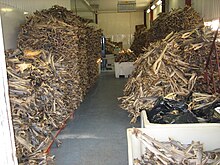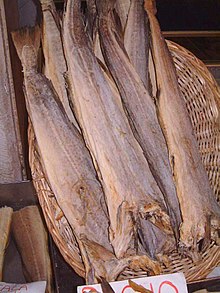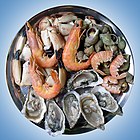Stockfish

Drying flake ('hjell') in Norway
Stockfish is unsalted fish, especially cod, dried by cold air and wind on wooden racks (which is called "hjell" in Norway) on the foreshore. The drying of food is the world's oldest known preservation method, and dried fish has a storage life of several years. The method is cheap and effective in suitable climates; the work can be done by the fisherman and family, and the resulting product is easily transported to market.
Cod is the most common fish used in stockfish production, while other whitefish, such as pollock, haddock, ling and cusk, are used to a lesser degree.[citation needed]
Over the centuries, several variants of dried fish have evolved. The stockfish (fresh dried, not salted) category is often wrongly mixed with the clipfish, or salted cod, category where the fish is salted before drying. After 2–3 weeks in salt the fish has salt-matured, and is transformed from wet salted fish to clipfish through a drying process. The salted fish was earlier dried on rocks (clips) on the foreshore. The production method of clipfish was developed by the Portuguese who first mined salt near the brackish water of Aveiro, and brought it to Newfoundland where cod (bacalhau) was available in massive quantities. Salting was not economically feasible until the 17th century, when cheap salt from southern Europe became available to the maritime nations of northern Europe.
Stockfish is cured in a process called fermentation where cold-adapted bacteria matures the fish, similar to the maturing process of cheese. Clipfish is processed in a chemical curing process called salt-maturing, similar to the maturing processes of other salt-matured products like Parma ham.
Contents
1 Etymology
2 Importance
3 Manufacturing and usage
4 Dishes
5 Gallery
6 See also
7 Notes
8 References
Etymology

Stockfish warehouse in the village of Forsøl, Norway
The word stockfish is a loan word from West Frisian stokfisk (stick fish), possibly referring to the wooden racks on which stockfish are traditionally dried or because the dried fish resembles a stick.[1] "Stock" may also refer to a wooden yoke or harness on a horse or mule, once used to carry large fish from the sea or after drying/smoking for trade in nearby villages. This etymology is consistent with the fact that "Stockmaß" is German for the height of a horse at the withers. "Stockfish" and "Stockmaß" therefore refer essentially to the same basic length.
Importance
Stockfish is Norway's longest sustained export commodity. Stockfish is first mentioned as a commodity in the 13th-century Icelandic prose work Egil's Saga, where chieftain Thorolf Kveldulfsson, in the year 875 AD, ships stockfish from Helgeland in mid-Norway to Britain. This product accounted for most of Norway's trade income from the Viking age throughout the Medieval period.
Preserved cod fed Iceland for centuries, to the extent where it has been described as a local equivalent of bread.[2]
Stockfish is extremely popular and is widely consumed in Catholic Mediterranean countries, mostly in Portugal and secondly also in Italy. (Stockfish is called stoccafisso in most Italian dialects, but confusingly baccalà—which normally refers to salt cod—in the Veneto).[3]
Stockfish is a staple of Nigerian cuisine.[4]
Manufacturing and usage

Stockfish from cod in Venice, Italy
The science of producing good stockfish is in many ways comparable to that of making a good cognac, Parma ham, or a well-matured cheese. Practitioners of the Slow Food movement insists that all these artisanal products must be made on a small scale and given time to mature.
The fish is prepared immediately after capture. After gutting the fish, it is either dried whole, or split along the spine leaving the tail connected. The fish is hung on the hjell from February to May. Stable cool weather protects the fish from insects and prevents an uncontrolled bacterial growth. A temperature just above zero degrees Celsius, with little rain, is ideal. Too much frost will spoil the fish, as ice destroys the fibers in the fish. The climate in northern Norway is excellent for stockfish production. Due to the stable conditions, the stockfish produced in Lofoten and Vesterålen is often regarded as the best.[citation needed] The traditional cod harvest in Lofoten also takes place during the best drying time. Due to a milder and more humid climate, salted/dried whitefish (klippfisk) was more common in the fisheries districts of Western Norway.
After its three months hanging on the hjell, the fish is then matured for another two to three months indoors in a dry and airy environment. During the drying, about 80% of the water in the fish evaporates.[5] The stockfish retains all[citation needed] the nutrients from the fresh fish, only concentrated: it is therefore rich in proteins, vitamins, iron, and calcium.
After sorting by quality, most of the stockfish is exported to Italy, Croatia and Nigeria.[6] In Norway and Iceland, the stockfish is mostly used as a snack and for lutefisk production. In Italy, the fish (called stoccafisso) is soaked and used in various courses, and is viewed as a delicacy.
Low-quality stockfish is also commonly used as supplemental food for pets, primarily as dog food or dog treats.
The 2012–2015 project SafeTrackFood developed a method of indoor production of stockfish to accelerate the maturing and drying of the fish while ensuring safety, quality and traceability.
Dishes

The baccalà alla lucana: traditional recipe from Basilicata

A Dutch-Surinamese "broodje bakeljauw" in the Netherlands (a bun with sliced cucumbers and shredded and spiced stockfish)
The baccalà alla vicentina, an ancient and traditional Italian dish native to Vicenza, is made from stockfish (confusingly not from dried and salted cod, although this is known in standard Italian as baccalà) and is served on or next to polenta. In the Italian region of Basilicata, the so-called baccalà alla lucana is prepared with typical peppers called "cruschi" (dialect word for "crunchy").[7] Dishes made from stockfish (locally called bakalar) are traditionally eaten on Christmas Eve in Croatia, especially Dalmatia.
Stockfish is popular in West Africa,[8] where it is used in the many soups that complement the grain staples fufu and garri. Also the main ingredient in the Igbo snack called "Ugba na Okporoko" or "ukazi" amongst the Ohafia people in Abia state in Nigeria. Indeed, in Abia stockfish is quite popular and a regular ingredient used in many local delicacies. Little wonder most importers of "okporoko" are based in the town of Aba in Abia State. Among the Umuahia people, at festive periods, the best staple is the Ukazi soup which must necessarily be very well garnished with okporoko or Cod as it is popularly called. The Kwe people, who are a fishing people of the English-speaking part of Cameroon, use stockfish in flavoring their palm nut or banga, which can be eaten with a cocoyam pudding called kwacoco. The name okporoko for stockfish, among the Igbo of Nigeria refers to the sound the hard fish makes in the pot and literally translates as "that which produces sound in the pot".
Both stockfish and salt cod can be made into lutefisk.
Stockfish is typically sold in whole bales (100 lbs per bale) or half-a-bale, one-quarter bale or even one-tenth-bale.[citation needed]
Gallery
Cod hung for drying in Lyngen fjord, Norway
Stockfish up for drying in Iceland

Women working with stock fish in Iceland c. 1915

Indian village showing native method of drying salmon, c. 1888.

Stomach of a sea lion used by Aleut natives to store dried red salmon
See also
- Boknafisk
Bugeo – similarly dried Alaska pollock- List of dried foods
- Lofoten Stockfish Museum
Notes
^ Kurlansky, chapter 3; cf. OED s.v. 'stockfish': "the reason for the designation is variously conjectured"
^ Kurlansky, chapter 9
^ La differenza tra stoccafisso e baccalà
^ "Nigeria's love affair with a Norwegian fish"..mw-parser-output cite.citation{font-style:inherit}.mw-parser-output .citation q{quotes:"""""""'""'"}.mw-parser-output .citation .cs1-lock-free a{background:url("//upload.wikimedia.org/wikipedia/commons/thumb/6/65/Lock-green.svg/9px-Lock-green.svg.png")no-repeat;background-position:right .1em center}.mw-parser-output .citation .cs1-lock-limited a,.mw-parser-output .citation .cs1-lock-registration a{background:url("//upload.wikimedia.org/wikipedia/commons/thumb/d/d6/Lock-gray-alt-2.svg/9px-Lock-gray-alt-2.svg.png")no-repeat;background-position:right .1em center}.mw-parser-output .citation .cs1-lock-subscription a{background:url("//upload.wikimedia.org/wikipedia/commons/thumb/a/aa/Lock-red-alt-2.svg/9px-Lock-red-alt-2.svg.png")no-repeat;background-position:right .1em center}.mw-parser-output .cs1-subscription,.mw-parser-output .cs1-registration{color:#555}.mw-parser-output .cs1-subscription span,.mw-parser-output .cs1-registration span{border-bottom:1px dotted;cursor:help}.mw-parser-output .cs1-ws-icon a{background:url("//upload.wikimedia.org/wikipedia/commons/thumb/4/4c/Wikisource-logo.svg/12px-Wikisource-logo.svg.png")no-repeat;background-position:right .1em center}.mw-parser-output code.cs1-code{color:inherit;background:inherit;border:inherit;padding:inherit}.mw-parser-output .cs1-hidden-error{display:none;font-size:100%}.mw-parser-output .cs1-visible-error{font-size:100%}.mw-parser-output .cs1-maint{display:none;color:#33aa33;margin-left:0.3em}.mw-parser-output .cs1-subscription,.mw-parser-output .cs1-registration,.mw-parser-output .cs1-format{font-size:95%}.mw-parser-output .cs1-kern-left,.mw-parser-output .cs1-kern-wl-left{padding-left:0.2em}.mw-parser-output .cs1-kern-right,.mw-parser-output .cs1-kern-wl-right{padding-right:0.2em}
^ Kurlansky, chapter 2
^ Frederick Forsyth, who covered the 1967-1969 Nigerian Civil War as a reporter, noted that dried fish imports from Norway were a key source of protein for the nation. Forsyth, Frederick. The Outsider: My Life in Intrigue. NY: Putnam, p. 176
^ "Salt Cod with Cruschi Peppers". Basilicata cultural society of Canada. 18 August 2012. Retrieved 23 February 2014.
^ Dale, Penny; Uwonkunda, Victoria (27 November 2017). "Nigeria's love affair with a Norwegian fish". BBC News.
References
| Wikimedia Commons has media related to Stockfish. |
- Kurlansky, Mark (1997). Cod: A Biography of the Fish That Changed the World. New York: Walker.
ISBN 0-8027-1326-2. - http://www.safetrackfood.eu/





